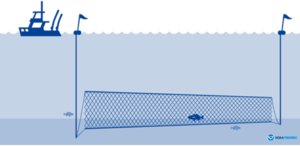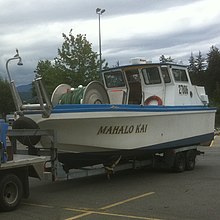
Back صيد بالشباك الخيشومية Arabic Tremall Catalan Tremaglioni Corsican Drgùba CSB Stellnetz German Trasmallo Spanish Tresmail Basque صید گوشگیر Persian Kalaverkko Finnish Filet maillant French


Gillnetting is a fishing method that uses gillnets: vertical panels of netting that hang from a line with regularly spaced floaters that hold the line on the surface of the water. The floats are sometimes called "corks" and the line with corks is generally referred to as a "cork line." The line along the bottom of the panels is generally weighted. Traditionally this line has been weighted with lead and may be referred to as "lead line." A gillnet is normally set in a straight line. Gillnets can be characterized by mesh size, as well as colour and type of filament from which they are made. Fish may be caught by gillnets in three ways:
- Wedged – held by the mesh around the body.
- Gilled – held by mesh slipping behind the opercula.
- Tangled – held by teeth, spines, maxillaries, or other protrusions without the body penetrating the mesh.
Most fish have gills. A fish swims into a net and passes only part way through the mesh. When it struggles to free itself, the twine slips behind the gill cover and prevents escape.[1]
Gillnets are so effective that their use is closely monitored and regulated by fisheries management and enforcement agencies. Mesh size, twine strength, as well as net length and depth are all closely regulated to reduce bycatch of non-target species. Gillnets have a high degree of size selectivity. Most salmon fisheries in particular have an extremely low incidence of catching non-target species.[2]

A fishing vessel rigged to fish by gillnetting is a gillnetter. A gillnetter which deploys its gillnet from the bow is a bowpicker, while one which deploys its gillnet from the stern is a sternpicker. Gillnets differ from seines in that the latter uses a tighter weave to trap fish in an enclosed space, rather than directly catching the fish as in a gillnet.
- ^ Murphy, B.; Willis, D. (1996). Fisheries Techniques (2nd ed.). Bethesda, MD: American Fisheries Society. Archived from the original on 2013-02-21.
- ^ Selective Fisheries (PDF) (Report). Oregon Department of Fish and Wildlife. Archived from the original (PDF) on 2016-03-03. Retrieved 26 September 2014.
© MMXXIII Rich X Search. We shall prevail. All rights reserved. Rich X Search